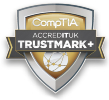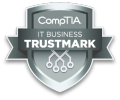Governance, Risk & Compliance
In today’s cyber-security threat landscape every business, regardless of scale or size, needs to consider how they keep secure and protected from threats both inside and outside the organisation. Our range of ‘managed services add-ons’ provide multiple layers of solutions, supporting your governance, risk and compliance needs, whilst enhancing your cyber-security posture and remaining budget-friendly.
CYBER-SECURITY
Your Governance, Risk & Compliance Partner
Let’s start at the begining. What do we mean when we talk about Governance, Risk & Compliance (GRC) when it comes to cyber-security?
In the context of cybersecurity, GRC refers to the processes and policies that organisations put in place to manage and mitigate the risks associated with their use of technology. This includes ensuring compliance with relevant laws and regulations, identifying and assessing potential threats, implementing controls to prevent or respond to incidents, and continuously monitoring and improving the overall effectiveness of the organisation’s cybersecurity program.

Cyber Essentials
NIST Framework
Backups & Business Continuity
Cyber-Security Governance
Cyber-security governance refers to the overall management and oversight of an organisation’s cyber-security program. It involves setting policies, standards, and procedures for protecting sensitive information and systems from unauthorised access, use, disclosure, disruption, modification, or destruction.
The main goal of cyber-security governance is to ensure the protection of your sensitive information and systems while maintaining the availability, integrity, and confidentiality of data. This is achieved through the implementation of a comprehensive set of security controls, including technical, administrative, and physical controls, incident management procedures, and security awareness training.
Cyber-security governance also involves creating a structure that clearly defines roles and responsibilities for managing and implementing security controls, as well as establishing a governance framework that aligns with the overall strategic objectives of your business or organisation.
Overall, Cyber-security governance is critical to help organisations effectively manage the risks associated with the use of technology and to ensure that they are able to protect sensitive information, maintain business continuity, and comply with legal and regulatory requirements.

Malware Prevention
E-mail Filtering & Phishing Prevention
Insider Threat Prevention
Security Awareness Training
Password Management
Next-Generation Firewalls
Cyber-Security Risk
Cyber-security risk management is the process of identifying, assessing, and prioritising the potential security threats to your business, and then implementing controls to mitigate or prevent those risks. This process typically involves several steps, such as:
Identifying and assessing potential threats: This includes identifying the assets and systems that are most critical to your business, as well as the potential consequences of a security incident.
Prioritising risks: Once potential threats have been identified, they need to be prioritised based on their likelihood and impact.
Implementing controls: Based on the risks identified, controls are implemented to prevent or mitigate those risks. This could include technical controls, such as firewalls and intrusion detection systems, as well as administrative controls, such as security awareness training and incident response plans.
Continuously monitoring and improving: Cyber-security risks are constantly changing, so the risk management process must be ongoing. This includes continuously monitoring for new threats, evaluating the effectiveness of existing controls, and making adjustments as necessary.
By implementing a cyber-security risk management program, organisations can proactively identify and address potential threats, rather than simply reacting to incidents after they occur.

Cyber Essentials
NIST Framework
User Activity Monitoring
Data Loss Prevention
Virtual Blue Team
Cyber-Security Compliance
Cyber-security compliance refers to the process of adhering to a set of rules and regulations in place to protect your sensitive information and systems from unauthorised access, use, disclosure, disruption, modification, or destruction. This can include compliance with laws, industry standards, and regulations related to data privacy, data security, and incident reporting.
Examples of regulations and standards include:
- The General Data Protection Regulation (GDPR)
- Payment Card Industry Data Security Standards (PCI DSS) for businesses that accept credit card payments
- The Financial Conduct Authority (FCA) requirements for regulated financial services firms
Cyber-security compliance also includes regular audits, testing, and certifications to ensure that your security controls are in place and functioning as intended. Those responsible for compliance are responsible for ensuring that the organisation is following the relevant regulations and standards and often responsible for creating and updating policies and procedures to meet the requirements of these regulations.
Being compliant with these regulations is not only important for legal reasons, but also to demonstrate that the you’ve taken the necessary steps to protect your assets, clients, and partners’ sensitive data, and to avoid reputational damage.
GRC
How Team Metalogic can help
It’s one thing knowing how Governance, Risk & Compliance relate to your cyber-security considerations, but it’s another knowing what you should put in place to support your business in hardening its’ cyber-security posture and minimising the risk of attack, breach or loss.
That’s why we’ve put together three simple pillars, bolt-ons to our regular Managed Services Agreements, that align innovative, current and budget-friendly technology solutions to the three principles of Governance, Risk & Compliance.
Our GRC Agreement Add-Ons are designed to stack multiple layers of solutions, providing what we call ‘defence in depth’, at an affordable monthly price and targeted at your specific GRC requirements – security, compliance and/or business continuity. And as a fully managed solution, there’s no complicated agreements or complex billing – you get a simple single-line charge for each chosen add-on and we handle all of the various components for you:
MANAGED SECURITY
Per user / mailbox- Password Management
- Security Awareness Training
- E-mail Filtering
- Phishing Prevention, Detection & Response
- Phishing Simulations
- Threat Hunting
- Risk Analysis & Reporting
- Virtual Blue Team (optional extra)
MANAGED COMPLIANCE
Flat fee- Managed Cyber Essentials Certification
- NIST Framework Assessment
- User Activity Monitoring (optional – per user charge applies)
- Data Loss Prevention (optional – per user charge applies)
- Cyber Essentials Plus (optional extra)
MANAGED CONTINUITY
Per server / mailbox- M365 Backup
- Google Workspace Backup
- Xero Backup
- Quickbooks Backup
- Physical/Virtual Server Backup & Disaster Recovery
- Salesforce Backup (optional extra)
STRATEGIC PARTNER
Your Trusted Advisor
Watch this cyber-security vlog by our CEO, Mike Parfitt, to learn about how we support our partners with clear and concise cyber-security advice, ensuring you’re aware of the immediate risks to your business and continued operations from an always evolving threat landscape.
Wondering if we have the right solution for you?
We'd love to talkCall us on 0345 521 0618, e-mail [email protected] or fill in the call back form below
and one of our team will be in touch very soon.
Request a call back





